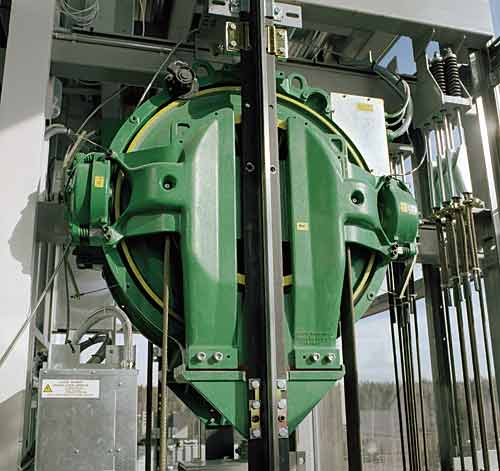New Elevator Technology: The Machine Room-Less Elevator
Â
|
Â
The advantages of the traditional traction elevator include:
- Fast speeds and efficient performance
- Quiet, smooth ride
- Available for high-rise applications
The drawbacks of the traditional traction elevator include:
- Higher installation cost
- Significant structural loads at the top of the hoistway
- Elevator machine room required
Â
Machine Room-Less Elevator
Development of the MRL gearless traction machine came about as a result of technological innovations that significantly reduced the size of electric motors used with traction systems. In the mid 1990s, elevator designs began featuring a small permanent-magnet synchronous motor (PMSM) combined with a variable voltage, variable frequency (VVVF) drive. The change reduced the size, weight, heat output and energy consumption of traditional traction systems by up to one-half. The energy savings in comparison to hydraulic systems are even more substantial. The technology was incorporated into elevators with the result that, because of the reduced size of the new motor, a machine room above or adjacent to the elevator hoistway was not required. Instead of placing the machine in a separate room, the motor mechanism could be mounted within the hoistway itself.
Â
Â
|
Â
This new technology created a cascade of environmental benefits. Not only did the new design lead to a reduced use of both oil and energy for starting and running the elevator-plus the avoidance of potential ground contamination-it also led to more efficient and safe installation techniques and use of valuable interior space. Used abroad for many years, the MRL is the standard product for low to mid-rise buildings in Europe and Asia where the hydraulic system is almost extinct.
The United States has trailed the rest of the world in the adoption of the new Machine Room-Less elevator system. When it was first introduced, there was a slow acceptance rate because of code requirements, since national and local building codes did not address elevators without machine rooms.
In 1998, work started on addressing all safety aspects with regard to the Machine Room-Less elevator type of design. Seven years later, the American Society of Mechanical Engineers (ASME) issued a special supplement to its A17.1 Safety Code for Elevators and Escalators. That supplement, named A17.1S-2005, contained all of the pertinent safety elements related to issues involved with MRLs.
Earlier this year ASME incorporated that supplement into its latest edition, A17.1/CSA B44 - 2007 Safety Code for Elevators and Escalators. This 2007 edition covers Canada (elevator codes are now harmonized for all of North America) and covers the design, construction, operation, inspection, testing, maintenance, alteration, and repair of elevators. The American National Standards Institute (ANSI) has approved the ASME elevator code as a national standard.
Before the issuance of national standards, state and local code officials approved MRLs on an individual-case basis. Since then, many authorities have adopted the latest ASME code. With a growing number of MRL suppliers, national standards and increased adoption of national standards by local code bodies, the number of Machine Room-Less elevator installations in the United States is expected to increase dramatically.
Â











